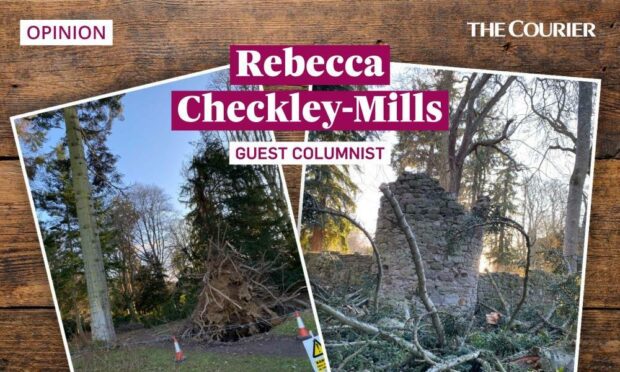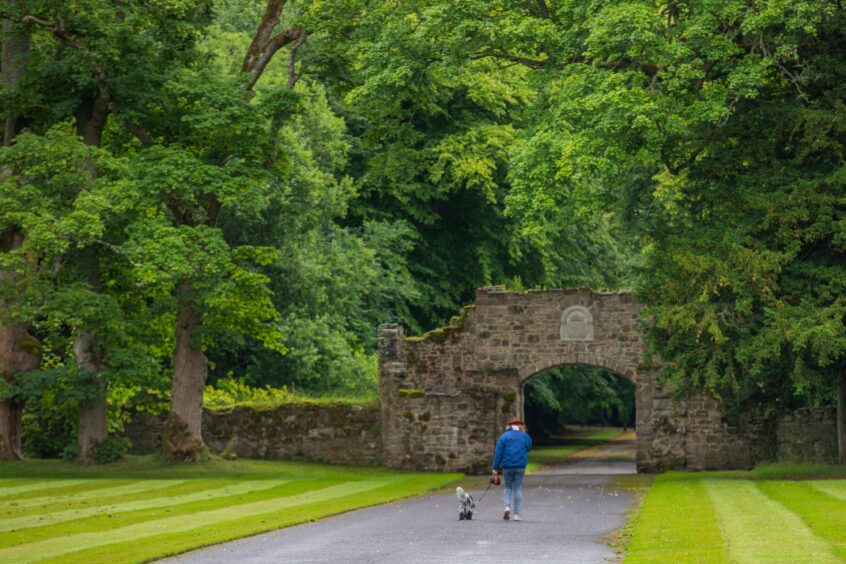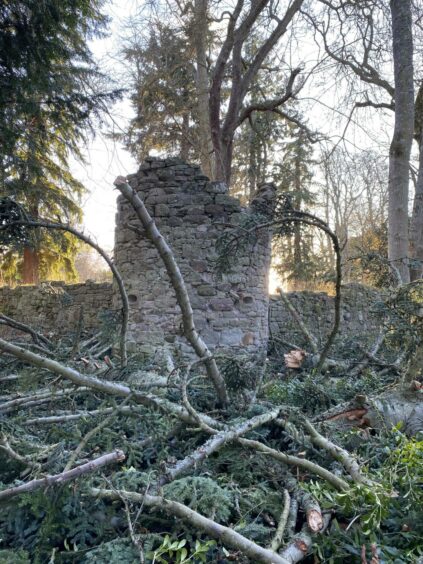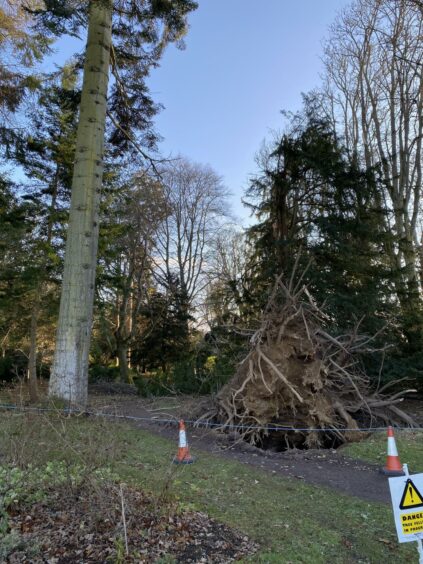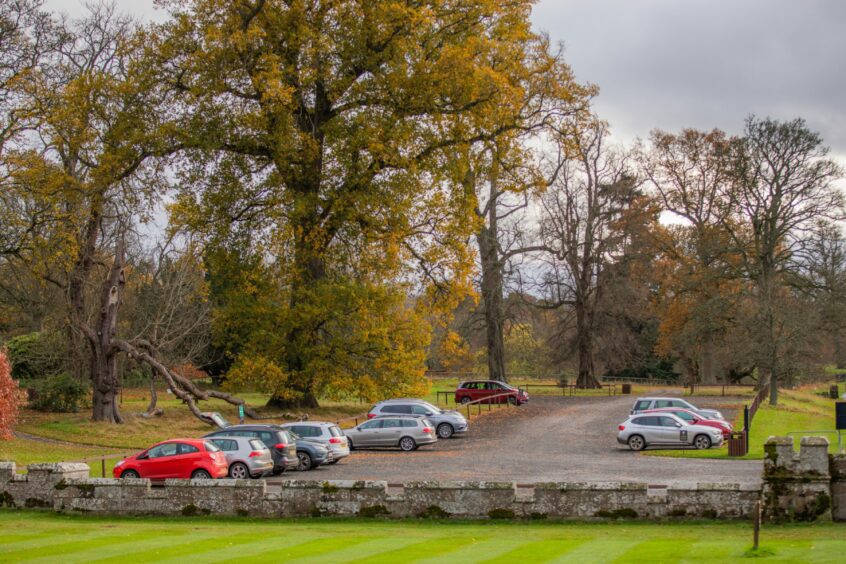The Brazilian novelist Paulo Coelho de Souza once wrote, “In a forest of a thousand trees, no two leaves are alike. And no two journeys along the same path are alike”.
That is the beguiling nature of woods and forests, they enchant you but can often deceive you.
As you look upon a wood its depth is hidden from view.
And if you look up, you see the tree tops reaching up along the horizon, like a score of music notes playing a melody across the sky.
No two journeys through the parkland up to Scone Palace are the same.

Of course the views change from season to season. But the characteristic of the parkland can change multiple times within a single day.
Sometimes the parkland and trees can take on a foreboding feeling, especially if dark, ruinous weather is coming in from over the Grampian Mountains in the North.
And then a moment later, the clouds will part and the parkland comes alive in the light, radiating a kaleidoscope of colour that only nature can provide.
Trees are part of our heritage: their future is less certain
Trees are an integral part of Scottish culture; Gaelic folktales are full of stories about them.
They believed that different species of trees could offer them guidance and spiritual wellbeing.
The great oak for example, was believed to give strength, courage and protection.
The Scots pine was a symbol of purification. In some cultures, it was believed that the Gods dwelled within them.
Scotland’s ancient Caledonian forests grew at the end of the last ice age. And despite the injuries caused to them by man over time, parts of them still remain with us and are all the more precious for it.
But while man is the main culprit of the loss of trees on earth, he is not the sole perpetrator. Mother Nature has a hand in it too.
And with weather patterns changing as a result of climate change, we are seeing the damage done by storms all too more often these days.
Storm Arwen took its toll on Scone Palace
On November 26, the Met Office issued a red warning for strong winds across the north of England and Scotland.
Storm Arwen accumulated wind speeds averaging 69mph with the strongest wind speed of 98mph recorded in Northumberland.
It has been described as one of the most damaging storms of the last decade.
Arriving at Scone Palace the morning after Storm Arwen was a jarring and freakish experience.
Everything seemed to have been picked up and put back out of place, like a gust of wind had blown a thousand papers from a row of pigeon holes onto the floor at your feet.
The paths were covered with scattered debris and branches hang precariously from the statuesque trees on which they once grew.
Perhaps, compared to other estates, Scone got away lightly, only losing seven of its biggest trees, but to see generations of trees lying wounded, battle-beaten on the ground is heart-breaking.
During the night, as the wind howled around the Old Stables, one of the resident groundsmen was awoken by an earth-shuddering crash.
One of Scone’s oldest and most magnificent pines had succumbed and was ripped up in the relentless northerly winds.
It narrowly missed the medieval wall that surrounds the ancient site of Moot Hill as it fell.
You never fully appreciate the nobility of such trees until you walk the full length of one as it lies, lifeless in state.
These gardens were created for everyone to enjoy
The gardens at Scone Palace can boast an impressive horticultural lineage.
Designed in 1804 by the famous Scottish botanist and author, John Claudius Loudon (1783-1843), they are one of the earliest examples of his work in Britain.
He introduced the term ‘arboretum’ into the British language of cultivation and is considered to be the founder of the modern garden, democratising gardening by extolling its pleasures and rewards to all levels of Victorian society.
His ‘gardenesque’ theory embraced the wild and irregular inclinations of nature.
And at Scone, we see these early principles and beliefs begin to take shape.
Old trees stand where the seedling would naturally have fallen. Rugged paths weave in between majestic trees and textured slopes offer unexpected views.
Walking through Scone you feel more connected with the beauty of the natural world.
But perhaps Loudon’s greatest legacy was to ensure that everyone had access and opportunity to enjoy public spaces and gardens.
For him, gardening and the appreciation of it did not belong solely to the upper echelons of society.
The Scone man who introduced 240 trees to Britain
Near the Victorian Pinetum is a Douglas fir that was raised from a seeding bought back from America in 1826.
David Douglas was born in the village of Scone in 1799 and went on to become a world renowned explorer and plant hunter.
Matt and Tina thoroughly enjoying their staycation in Scotland and they decided to visit us in bonnie Perthshire.
The couple had a lovely time walking around the grounds with their Spaniel Olive. One of their favourite spots was the Gaint Redwood avenue in the Pinetum 🌲 pic.twitter.com/nCVsuAsFMG
— SconePalace (@SconePalace) July 5, 2021
After he finished school, he worked as an apprentice at Scone under the head gardener William Beattie for seven years.
Douglas went on to introduce the fir to British cultivation in 1827.
In fact, he introduced around 240 species to Britain, including the Grand and Noble Firs, both of which, along with Giant Redwoods, can be found in our historic Pinetum.
Storm Arwen has changed our skyline irreparably
And so what does the future hold for our ancient trees in the wake of climate change?
There is little doubt that the challenges are great.
In the aftermath of Storm Arwen, many forests and estates had to close for essential work.
It will be many weeks before some of them are able to reopen to the public, as specialist forestry support is in high demand.
This does give landowners the time to reassess and reflect on the future planting of their estates.
Some may choose to replace fallen trees with more hardy species that can withstand these changes in weather patterns.
But whilst devastation brings renewed opportunities, it doesn’t detract from the simple fact that, with most ancient trees taking up to 150 years to mature, the skyline has changed irreparably for many, many years to come.
Rebecca Checkley-Mills works as a guide at Scone Palace and writes the Home By The Loch blog.
